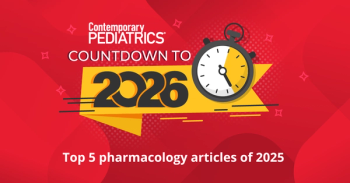
Full case: A newborn baby with a rash
The baby had mild respiratory distress after delivery and briefly required supplemental blow-by oxygen during transitioning.
Case history
A 21-year-old primigravida woman presented to the hospital in preterm labor, with an otherwise uneventful pregnancy except for a febrile illness after exposure to family members with measles a week prior.
She reported having fever, cough, conjunctivitis, and a rash that started on her face and spread to her trunk, consistent with measles. Her fever and symptoms had mostly resolved, except for her lingering rash that began 6 days earlier. In the delivery room, she still had fresh excoriation marks on her arms. She had not received any measles-mumps-rubella (MMR) vaccines.
Six hours after admission, the patient delivered a female newborn via spontaneous vaginal delivery at 35 weeks of gestation. The baby weighed 2410 g, which was approximately the 50th percentile for her gestational age. The baby had mild respiratory distress after delivery and briefly required supplemental blow-by oxygen during transitioning. Apgar scores of 8 at 1 minute and 9 at 5 minutes were given at delivery. The baby subsequently improved and was allowed to room in with her mother, without the need for neonatal intensive care unit (NICU) admission. The nursing staff noticed a rash on the baby’s back.
Prenatal laboratory tests
Laboratory test results came back negative for group B Streptococcus and were nonimmune for rubella. Maternal sexually transmitted disease laboratory test results were negative, and all other prenatal laboratory test results were unremarkable. The measles reverse transcriptase polymerase chain reaction (RT-PCR) test results came back positive in both mother and baby.
Newborn physical examination
The baby’s general physical examination results were normal except for mild respiratory distress that subsequently resolved within 2 hours. Other pertinent physical findings:
- Neurological: Newborn sleepy but arousable, with slightly decreased tone and reflexes consistent with preterm gestational age
- Lungs: Clear on auscultation, with intermittent tachypnea without significant respiratory distress
- Skin: Maculopapular erythematous exanthem scattered over baby's back and trunk consistent with measles (Figure 1)
Diagnosis
- Preterm infant of 35 completed weeks of gestation
- Congenital measles without complication
- Transient neonatal hypoglycemia
- Transient tachypnea of the newborn
Hospital course
Although the mother was beyond the 4-day infectious period for measles and was no longer infectious, both she and her baby were placed in airborne isolation with contact precautions in a negative-pressure room due to the risk of congenital measles, pending the results of viral studies. An infectious disease specialist was consulted, and the baby was started on empiric measles treatment with immune globulin intramuscular (IGIM) and vitamin A, pending results of measles investigations. The hospital did not have the capability to perform measles testing, so the sample was sent to the state laboratory for confirmation. An oropharyngeal sample was submitted for measles RT-PCR testing, results of which later returned positive.
The baby did not have significant respiratory distress or require supplemental oxygen, and her tachypnea progressively improved over 4 hours. The baby was afebrile but subsequently developed hypothermia and was transferred to a NICU airborne isolation room. The baby had feeding difficulties initially, but her feeding progressively improved within the first 2 days of admission. She also had transient hypoglycemia and had to be given glucose gel.
All the baby’s symptoms could be explained by her prematurity except for the rash observed on the back, which improved during hospital stay and was gone by day 3 when she was discharged home. The mother declined routine erythromycin, hepatitis B vaccine, and vitamin K despite counseling on the risks and benefits.
Results of initial laboratory evaluations are summarized in the accompanying Table 1.
Discussion
This case brings awareness of an uncommon presentation of measles in the newborn as well as awareness about the dangers of vaccine refusal. Amid the recent measles outbreak in West Texas, the mother in this case was from a community susceptible to measles due to common vaccine refusal.1 This case could have been prevented by routine childhood immunization for measles.
The management of measles is aimed at prevention via routine immunization according to the American Academy of Pediatrics (AAP) immunization schedule. However, the MMR vaccines cannot be given in pregnancy because of the theoretical risk of causing harm to the fetus when the mother receives a live virus vaccine.2
With the introduction of the measles vaccination program, the number of measles cases decreased significantly during the late 1960s and early 1970s. One dose of measles-containing vaccine administered at the age of 12 months or older was approximately 94% effective in preventing measles (range, 39%-98%).2 Figure 2 shows this decline in the number of measles cases in the United States from 1961 through 2025 after the introduction of the 1-dose measles vaccination program.2 Endemic measles was declared eradicated from the United States in 2000.4
However, since 2020, due to increased incidence of vaccine refusal, there has been a resurgence in measles reports in the United States. According to the CDC, “During 2020-2023, 241 measles cases were reported in the United States, and the median number of measles cases reported per year was 53 (range: 13 to 121 cases/year).”3
Diagnosis of measles
The diagnosis of measles is based on clinical examination, history, and confirmatory testing. The confirmatory testing of patients suspected with measles should ideally include both serologic testing and specific detection of measles viral RNA by nucleic acid amplification test (NAAT) such as the RT-PCR. Diagnosis can also be confirmed by a 4-fold increase in measles IgG antibody in 2 specimens collected at least 10 days apart or by isolation of the measles virus in cell culture.2
Following measles virus infection in an unvaccinated individual, measles IgM antibodies appear within the first few days (1 to 4 days) of rash onset and peak within the first week after rash onset. IgM testing is most sensitive 3 or more days after rash onset and may be detectable for up to 6 to 8 weeks after rash onset.3
The diagnosis of congenital measles through viral RNA testing is typically not available in most hospitals. Treatment was initiated for the baby based on the maternal history and her presentation with a morbilliform rash to prevent measles complications while awaiting the final laboratory results.
The measles real-time RT-PCR test is reliable and has a sensitivity and specificity greater than 90%.2 A positive result indicates the presence of measles virus. Specific viral detection with RT-PCR can also mitigate the impact of early false-negative IgM in infants.3
Treatment
There are currently no specific antiviral treatments developed for measles. Measles virus is susceptible in vitro to ribavirin, which has been administered by the intravenous and aerosol routes to treat severely affected and immunocompromised children with measles.5
Vitamin A: The World Health Organization recommends vitamin A for all children with measles because it has been shown to decrease morbidity and mortality.6 Vitamin A for treatment of measles is administered once daily for 2 days. This regimen was given to our baby without any obvious adverse effects.
Vaccination: Measles-containing vaccine should be considered in all exposed individuals who are eligible. Evidence suggests that if the vaccine is given within 72 hours of measles exposure to susceptible individuals, it will provide protection or disease modification in some cases.5
The postexposure prophylaxis for measles can be administered according to the guidelines outlined in the AAP Red Book and the recommendations of the CDC adult schedule in Table 2.5
Immune globulin for prevention of measles
Human immune globulin (IG), a blood product prepared from the plasma of thousands of donors, provides antibodies for short-term prevention of infectious diseases such as measles. Persons who have measles disease typically have higher measles antibody titers than persons who have vaccine-induced measles immunity.7 IG preparations can be administered intramuscularly, intravenously, or subcutaneously.
Historically, IGIM has been the preferred choice for short-term measles prophylaxis and has demonstrated proven efficacy for measles postexposure prophylaxis.8 The recommended dose of IGIM is 0.5 mL/kg. IGIM has been used as prophylaxis to prevent or lessen the severity of measles and was shown to reduce the risk for measles if administered within 6 days of exposure.7
Measles susceptibility in babies
Babies are usually protected from measles at birth by passively acquired maternal antibodies. The extent of this protection depends largely on the amount of antibody transferred, which is related to gestational age and maternal antibody titer.9
However, mothers with vaccine-derived measles immunity typically have lower antibody titers and provide shorter protection to their baby compared with mothers with immunity derived from direct measles infection.9 Thus, infants born now are more susceptible to measles at a younger age. Findings from seroepidemiologic studies already indicate that 7% of infants born in the United States may lack antimeasles antibodies at birth and up to 90% of infants might have seronegativity by 6 months.2 These findings suggest a change in the window of vulnerability for measles infection during infancy and a strong need to preserve herd protection and access to immunoglobulin products when postexposure prophylaxis is needed.2
Infection prevention
In addition to standard precautions, airborne transmission precautions are indicated for 4 days after the onset of rash in otherwise healthy children and for the duration of illness in immunocompromised patients.5
Outbreak control
Every suspected measles case should be reported immediately to the state and local health department, which can help with active surveillance for additional cases to prevent the spread of infection. Every effort must be made to obtain laboratory evidence that would confirm that the illness is measles and to provide postexposure prophylaxis if recommended.5
Differential diagnosis10
There are not many conditions that would present like our index patient with generalized truncal maculopapular rashes at birth. However, several benign vesiculopustular eruptions appear in the newborn period. The differential diagnosis of generalized vesiculopustular newborn eruptions is listed below.
- Erythema toxicum
This common newborn skin lesion usually presents with multiple erythematous macules and papules that rapidly progress to pustules on an erythematous base. The lesions are not usually present at birth and typically occur on the second or third day of life and resolve within a week.
- Transient neonatal pustular melanosis
This skin condition may occur at birth as small nonerythematous pustules, present on the trunk and neck. The pustules do not have any surrounding erythema and eventually rupture into brown-black hyperpigmented macules with a surrounding collarette of scale that resolves within a few weeks. They are typically scattered on the face and sacrum and are not usually generalized to the trunk.
- Miliaria
This is a transient vesiculopapular skin lesion seen in newborns. The lesions are papular with minimal erythema. They are caused by the accumulation of sweat in obstructed sweat ducts. It is common in warm climates. It usually occurs after a few days and is not seen at birth.
- Infectious vesiculopustular eruptions
Several viral and bacterial infections can present with a skin lesion in the neonatal period. Most viral exanthems in the newborn are vesiculopustular and not maculopapular and are often localized. Lesions are rarely seen at birth and occur after a few days or weeks. Herpes simplex virus and varicella-zoster virus are the 2 most common viral infections, but the skin lesions caused by these viruses eventually become bullous and vesicular. There would be a preceding history of maternal viral infection.
- Congenital rubella
The skin lesions of rubella are typically papules and purpuric. They have been described as blueberry muffins because of the purpuric lesions. Our patient did not have any other symptoms suggestive of congenital rubella such as hearing loss or cataracts.
- Congenital syphilis
The skin lesions are small reddish-copper maculopapular eruptions. They could also present as hemorrhagic vesicles or bullae and petechiae that start on the palms and soles and spread to the trunk. If present at birth, congenital syphilis would also present with other symptoms such as nasal secretions and bone abnormalities.
- Congenital cutaneous candidiasis
This may present within 12 hours of birth. The lesions are small, diffuse, erythematous macules and pustules, often involving the palms and soles. There would be a preceding history of maternal infection.
- Cutaneous streptococcal infection
Skin manifestation of Streptococcus is uncommon in the newborn period. Group A Streptococcus may cause an erysipelas-like eruption. Skin lesions would typically be localized vesiculopustules, abscesses, or cellulitis.
- Congenital scabies
This is rare in high-income countries but may present within a few weeks with itchy skin that often affects the extremities. Lesions are localized initially but may spread to the trunk.
- Staphylococcal pustulosis
The skin lesions typically occur after a few days and are rarely seen at birth. This presents with localized, superficial, vesicular, pustular, or bullous lesions on an erythematous base. Lesions are usually found in areas of trauma, such as the diaper area, axillae, and periumbilical skin. Lesions rupture into superficial erosions and honey-colored crusts.
References
- Shastri D, Seitz A. A Texas child who was not vaccinated has died of measles, a first for the US in a decade. Associated Press. Updated February 26, 2025. Accessed February 26, 2025. https://apnews.com/article/measles-outbreak-west-texas-death-rfk-41adc66641e4a56ce2b2677480031ab9?utm_source=copy&utm_medium=share
- McLean HQ, Parker Fiebelkorn A, Temte JL, Wallace GS; CDC. Prevention of measles, rubella, congenital rubella syndrome, and mumps, 2013: summary of recommendations of the Advisory Committee on Immunization Practices (ACIP). MMWR Recomm Rep. 2013;62(RR-04):1-34.
- Filardo TD, Mathis A, Raines K, et al. Chapter 7: measles. In: Manual for the Surveillance of Vaccine-Preventable Diseases. CDC; 2019. Updated May 13, 2019. Accessed February 26, 2025. https://www.cdc.gov/surv-manual/php/table-of-contents/chapter-7-measles.html
- Katz SL, Hinman AR. Summary and conclusions: measles elimination meeting, 16-17 March 2000. J Infect Dis. 2004;189 (suppl 1):S43-S47.
- Measles. In: Kimberlin DW, Banerjee R, Barnett ED, Lynfield R, Sawyer MH, eds. Red Book: 2024–2027 Report of the Committee on Infectious Diseases. 33rd ed. American Academy of Pediatrics; 2024. doi:10.1542/9781610027373-S3_012_002
- Gans H, Maldonado YA. Measles: clinical manifestations, diagnosis, treatment, and prevention. UpToDate. Updated January 15, 2025. Accessed February 27, 2025. https://www.uptodate.com/contents/measles-clinical-manifestations-diagnosis-treatment-and-prevention
- Audet S, Virata-Theimer ML, Beeler JA, et al. Measles-virus-neutralizing antibodies in intravenous immunoglobulins. J Infect Dis. 2006;194(6):781-789.
- Janeway CA. Use of concentrated human serum gamma-globulin in the prevention and attenuation of measles. Bull N Y Acad Med. 1945;21(4):202-222.
- Lennon JL, Black FL. Maternally derived measles immunity in era of vaccine-protected mothers. J Pediatr. 1986;108(5 pt 1):671-676.
Newsletter
Access practical, evidence-based guidance to support better care for our youngest patients. Join our email list for the latest clinical updates.








